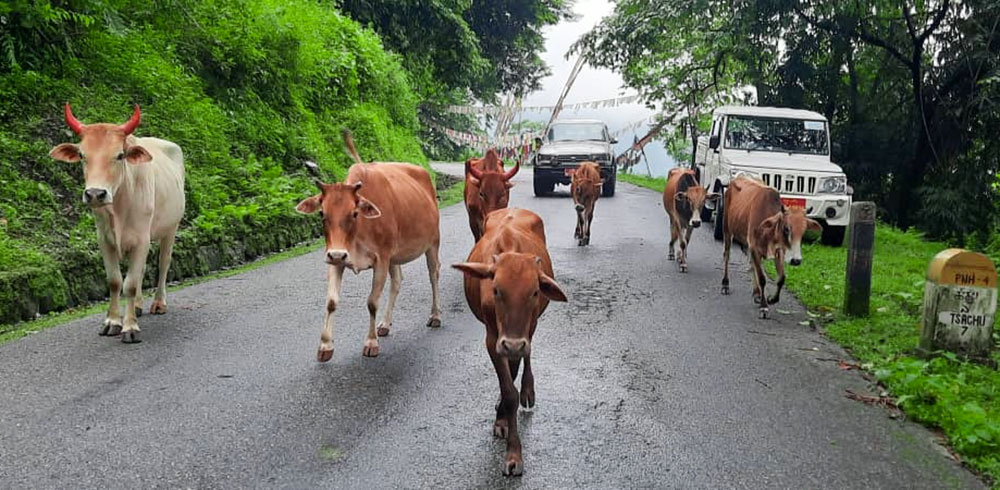DT asks BAFRA and livestock officials to regulate the rescued animals
Nima | Gelephu
Local leaders in Sarpang raised concerns over the lack of after-care for animals rescued by tshethar tshogpa during the recent dzongkhag tshogdu (DT).
The DT members wanted Bhutan Agriculture and Food Regularity Authority (BAFRA) and dzongkhag livestock office to regulate the works of tshethar tshogpa in the locality.
They claimed the rescued cattle are infested with worms, bones protruding sharply from the body and often hit by trucks carrying heavy loads.
Local leaders also said more than 100 cattle died in the dzongkhag so far without care.
The rescued cattle, mostly jersey-cross, were left to graze in the hilly areas of Serkem and Tamala in Jigmecholing, making it difficult for the cows to graze and find water.
Gups said the animals were not used to grazing in such locations.
Most animals were also found grazing along Gelephu-Trongsa highway, increasing the risk of accidents on the highway. Many animals also died after trucks carrying heavy loads hit them.
Gelephu Gup, Ugyen Wangchuk, said that the cattle were left unattended and not managed properly.
“Tshethar cattle are the next biggest problem in the gewog after flash floods, threats from the elephant, and the pandemic. People have to guard their crops against these stray cattle,” he said.
According to the gup, the government and relevant agencies should monitor the donations asked for tshethar.” The donations given by the people would go to waste. The cattle are left starving and without proper care.”
He said the government should ensure volunteers identify a pastureland, deploy a caretaker or herder to look after the cattle, and check if they have movement permit while moving the animals.
Local leaders from Jigmecholing, Sershong, Chuzergang, and Gelephu gewogs were also suspicious why the tshethar tshogpa members only rescue cows and oxen.
They alleged the members take the cattle from villages and announce on social media that it is being rescued from slaughterhouse.
A gup said members also make people from the villages contribute for transportation.
Chuzergang mangmi, Leki Wangchuk, said tshethar practice today is different from how it all began. “Collecting cattle from households was not encouraged. It was to rescue animals that were to be slaughtered.”
Local government officials from Sershong, Chuzergang, and drungkhag informed the tshethar tshogpa volunteer in Gelephu to come up with a management plan and follow the required guidelines.
“The volunteer was to report to the drungkhag and gewogs but we have not heard anything yet. We need strong regulation in place. Tshethar is good but it is important to have a proper management plan,” the mangmi said.
Officials from the dzongkhag livestock sector said that the coordinator, a civil servant was informed of regulations and guidelines while carrying out tshethar activities.
An official explained there should be an identified land or pastureland for the cattle. “Local government officials should be consulted while moving cattle from one gewog to another and the volunteers were to focus on rescuing animals that were taken to the slaughterhouse.”
He said the tshethar volunteer in Gelephu refused to respond to their suggestion. “Tshethar work is not done as per the guidelines.”
The livestock officer also said that any organisations or individuals wishing to carry out tshethar activities should be registered with the Civil Society Organisation Authority as a non-government organisation.
According to the guideline on animal tshethar practice 2018, any individual or organisation interested to take up tshethar activities should register their animal shelter meant for tshethar purposes with the local government before taking up any tshethar activities.
It also stated the number of animals allowed for tshethar shall be based on the carrying capacity of the animal shelter and the purchase of tshethar animals must be done in presence of BAFRA or livestock officials.
The guideline also mandates tshethar animals to be subjected to regular monitoring and any non-compliance would be dealt with as per the Livestock Rules and Regulation of Bhutan 2017.
The agriculture ministry developed the guideline to minimise the impact of tshethar animals on the environment and crops, and to ensure the welfare of the animals.
It was learned that the Tshethar Tshogpa volunteer in Gelephu resigned and there are over Nu 40,00,000 payment to be made for the cattle rescued so far.
Edited by Tashi Dema


